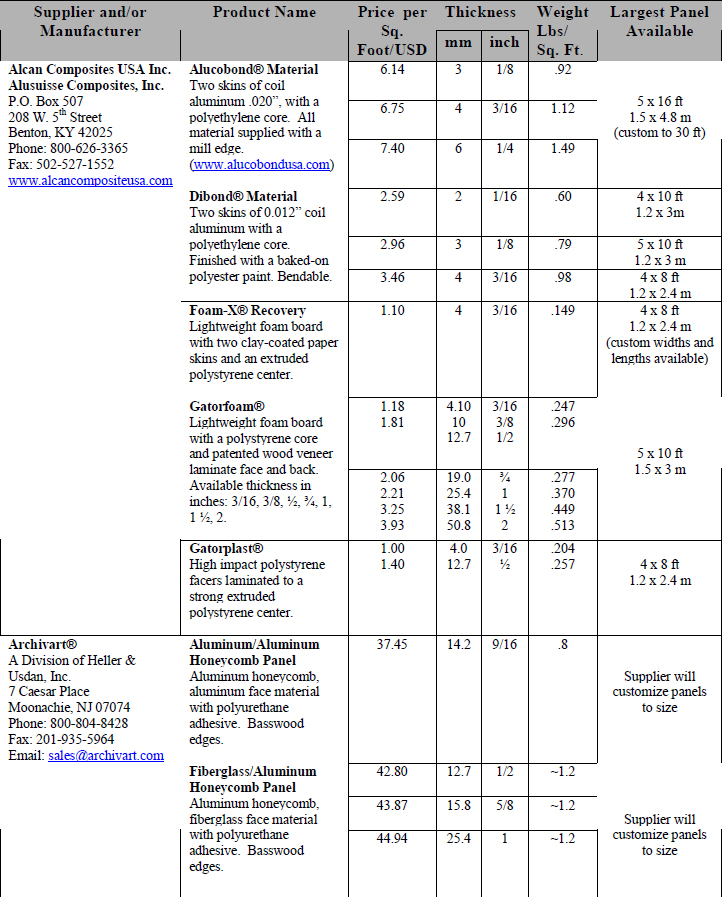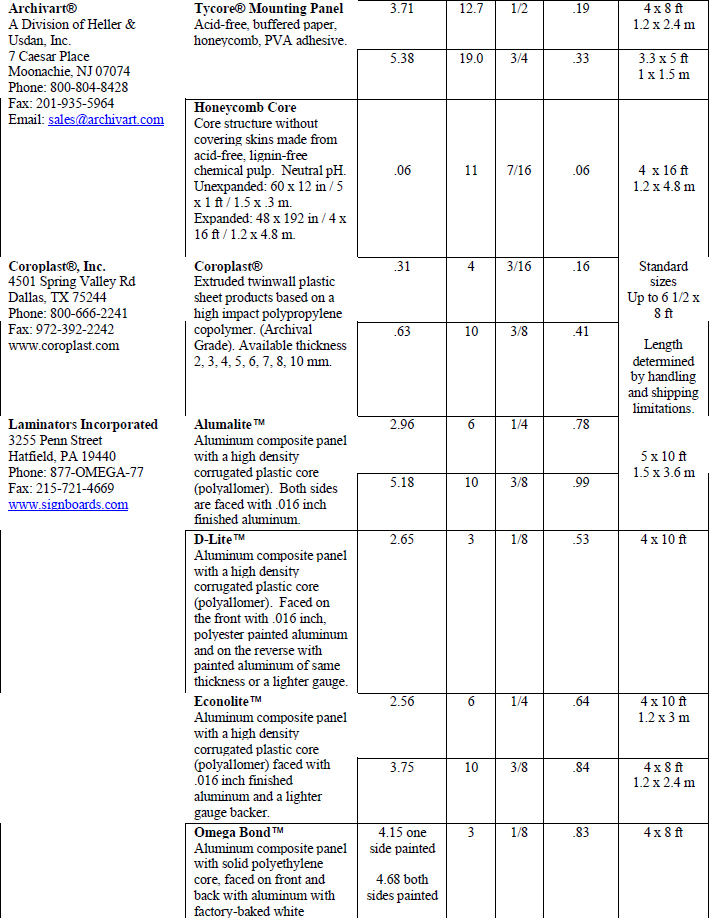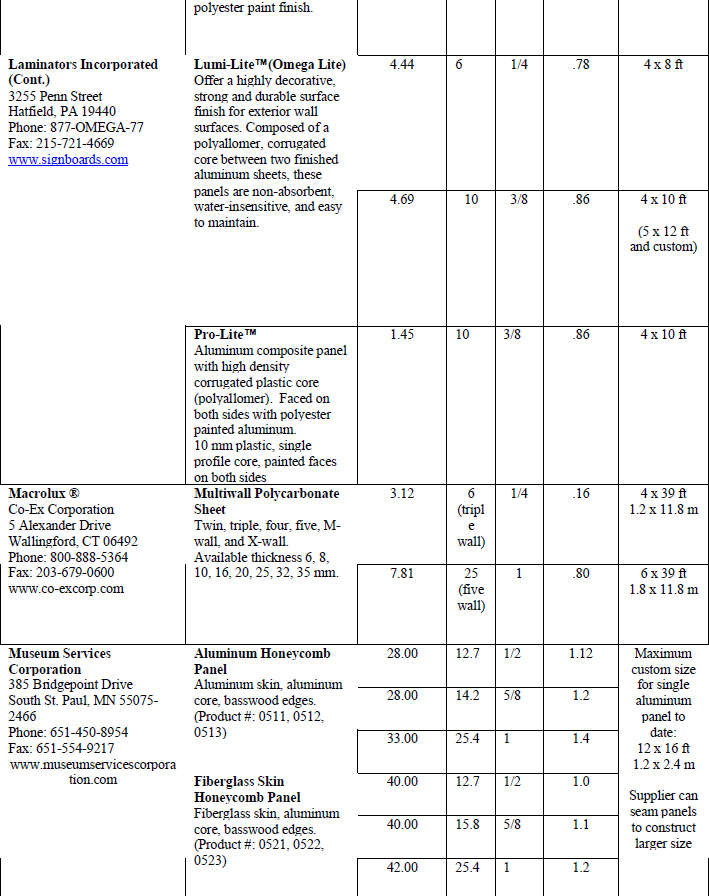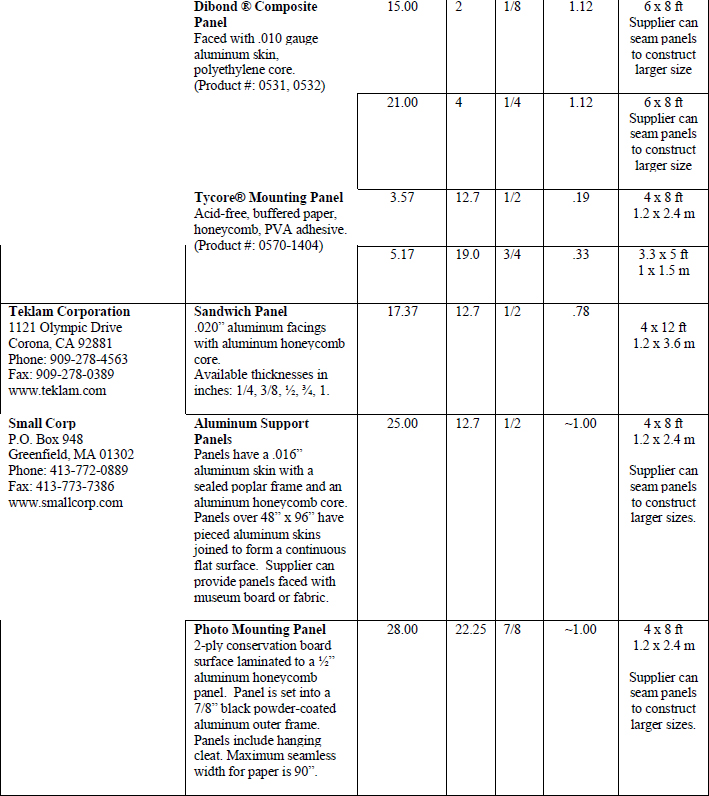
Topics in Photographic Preservation 2009, Volume 13, Article 12 (pp. 57-66)
Presented at the 2009 PMG Winter Meeting in Tucson, Arizona
The care of large photographs presents a wide variety of challenges to conservators. In 1997, the J. Paul Getty Museum (JPGM) made a change in collecting practices and began to acquire large format contemporary photographs. In 2007, Recent History: Photographs by Luc Delahaye was the first exhibition to consist entirely of large contemporary photographs. The exhibition was a collaborative project with the artist and museum staff, which required investigations into mounting techniques and materials, framing methods, and gallery display options. Some of the practical information gathered and lessons learned are presented in this article. An updated, previously published table detailing large-scale rigid support materials and a new table on adhesives available for mounting large works have been included.
The collection of photographs at the JPGM was established in 1984. In the twenty-five years since its inception, the collection and its associated exhibition program has experienced rapid evolution and growth. At present, the Getty Center for Photographs within the Museum consists of over 7000 square feet of gallery space permanently dedicated to the continuous display of photographs. At any one time, there are now as many as 300 photographs on display.
Recent History: Photographs by Luc Delahaye, an exhibition consisting of ten chromogenic photographs ranging in dimension from 5 × 7 to 6 × 10 feet, opened in 2007. Readying the prints for exhibition was the charge of conservation, a task made more complicated by the fact that there were five owners of the ten prints, including the artist. Equally important, Luc Delahaye was committed to being an active part of the installation process and worked closely with conservators to mount and frame the exhibition.
When work began on the project, several variables were in place: one print had just been acquired by the Museum and like two other prints lent by Delahaye, it arrived rolled and unmounted; two additional prints belonging to Delahaye were shipped mounted but unframed; four were framed, but unsatisfactorily, so they required reframing; and one was framed properly, but eventually required reframing when the decision was made to glaze each print with non-reflective acrylic (Tru Vue Optium).
From the beginning, Delahaye expressed strong opinions on the mounting, framing, and display specifications for the exhibition. Because several of the ten prints would potentially be acquired for the collection by the end of the exhibition, there was a responsibility to insure the prints were mounted and framed with the most reliable materials and techniques possible. It was necessary to balance this responsibility with Delahaye’s intentions and working techniques.
Beyond the scope of what most artists would prepare, Delahaye provided us with a mockup of his desired framing and mounting system, complete with four pages of instructions and a detailed list of the materials that should be used. Delahaye’s specifications were extremely thoughtful, but the curator and conservators of the exhibition felt some improvements could be made that would enhance the appearance of the images, increase the safety of the framed package, and ultimately prolong the life of the prints.
Methods for partially attaching the prints to rigid supports were considered, but Delahaye was adamant that his prints be mounted overall to a rigid support to achieve a desired smooth flat surface. The type of mounting substrate and adhesive used was not a concern for him. Once the overall mounting criteria were set, the decision was made to outsource the mounting to a mounting studio (Weldon Color Lab, Los Angeles) with a successful track record working with fine art prints.
To aid in our decision of the rigid support and adhesive to be used, we began with three already existing studies of these materials:
An updated Facini and Lussier table is reproduced here in Table 1. Table 2 is a compilation of manufacturer’s specifications of cold mount adhesives. Ideally materials to be used for prints in the Museum’s collection are based on independent analysis. In this case, due to time constraints for the Delahaye exhibition, the choice of materials was based on product specifications, discussions with technical support of product manufacturers and recommendations of colleagues.
Delahaye favored aluminum as a mounting substrate because of its availability in large sizes and its comparatively low cost. Following the inquiries into substrate options, it was agreed that anodized aluminum would be acceptable for the prints. Anodized aluminum is oxidized electroplated metal. Many metals are structurally weakened by corrosion, except for aluminum, which is strengthened through anodizing. The process involves placing a sheet of aluminum into a chemical acid bath. The aluminum becomes the positive anode of a chemical battery and the acid bath becomes the negative. The electric current passes through the acid and results in the formation of a thin layer of oxidized metal on the surface. This layer is an extremely hard, stable substance called anodized aluminum.
Aluminum is easy to find in varying thicknesses at dimensions smaller than 4 × 6 feet. Larger sheets at specific thicknesses, however, require orders to be made several months in advance. Anodized aluminum of this size is even more difficult to buy and must be ordered six to twelve months in advance. In this case, the aluminum was shipped out-of-state to Arizona to be anodized. Aluminum sheeting this large is considered an industrial material. It is typically not packed to prevent scratches or dents during shipping and handling so repacking was necessary. Each sheet was carefully inspected and cleaned before mounting. Cleaning consisted of polishing surfaces and removing fingerprints with ethanol.
As evident in the Table 1, there is a wide variety of large rigid supports other than aluminum available commercially. Each material has advantages and disadvantages. Aluminum composites, comprised of two thin sheets of aluminum that sandwich a polymer gel interior, (often polyethylene) can have very smooth surfaces and excellent rigidity. The addition of the gel interior reduces the overall weight considerably. Dibond is an aluminum composite we seriously considered for the Delahaye project but large sizes wider than 60” could not be obtained in time for the mounting process. Other prints in the collection have been mounted to Dibond with excellent results.
Delahaye provided Material Safety Data Information on the product he uses in Paris called Permacolor PT2113, manufactured and distributed by Mactac. It is also distributed in the US, but only available on 60” rolls, which were too narrow for seamless mounting of the Delahaye prints. In considering other alternatives, some adhesives of acceptable quality and dimension were found to be unstable at lower temperatures, precluding the long-term cold storage envisioned for the works. We selected an acrylic emulsion adhesive intended for face mounting of prints (Viewbond distributed by Quality Media Laminate Solutions) for this project. Available in 72” rolls, the adhesive met our requirements for cold storage and chemical stability. Many conservators and mounters prefer the acrylic adhesives used for face mounting because they are generally perceived to be of better quality. They are often formulated with UV inhibitors, have a nearly neutral pH and can be used at room temperature for mounting sensitive material like artwork.
The mounting system commonly used for large format materials in commercial studios is a roller laminator system. Roller laminators can be used with heat for thermal plastic adhesives or without heat for cold laminate or pressure sensitive adhesives. The roller laminator and the materials that are used in face mounting and lamination of photographs are often the same materials used for back mounting to substrates.
Framing systems for large photographs need to provide adequate protection and support, which can be a challenge when balanced with aesthetic requirements. Delahaye, like many other contemporary photographers, preferred a minimal frame profile, as evidenced in the mock-up he provided us. It was unknown to us at the time that the prints made for the exhibition were larger than any Delahaye had made to date. The frame design he provided had actually only been used for smaller prints. Upon closer examination of the design it became clear that some modifications were necessary. The oak frames were given slightly greater depth and poplar strainers were added to help prevent torque of the frames during handling. Seamed aluminum composite (Dibond) backing boards were also added. Even with these additions, the frames did experience some dimensional torque during handling. Plans to fabricate a handling frame for each print now in the collection are being considered. Altogether, seven of the ten prints received new frames, and the remaining three were retrofitted to accommodate a thicker glazing than originally presented in the mock-up.
The decision was made by the artist, curators, and conservators to use nonreflective museum acrylic glazing (Tru Vue Optium). We encountered some unforeseen problems with this product at larger dimension, which included bowing and the presence minor imperfections inherent from the production process that would normally be cut away with smaller sheets. We were able to resolve some of the planar distortion by switching to a single sheet of 6 mm thick glazing rather than 3 or 4 mm sheets we use for smaller works. The imperfections in the glazing were nearly invisible in the gallery. The manufacturer continues to work to resolve this problem. It has been suggested that we consider invisibly securing the glazing to the top of the frame, possibly with screws, to reduce sagging and bowing, but we have not attempted this modification yet.
To maintain an airspace between the glazing and the print surface, Delahaye’s system utilized a wooden spacer. The spacer was to be placed directly in contact with the print surface, and adjacent to the lip of the frame. The direct contact was a concern, but one that was not adequately addressed during the planning of the exhibition. As a temporary measure, the wood spacer surfaces were coated with a clear matte acrylic sealant and the frame packages were left unsealed to allow air exchange. These spacers will be changed in the future. One possible alternative under consideration is to digitally scan the wooden spacers and print archival inkjet reproductions, which will then be adhered to the visible side of acrylic spacers.
As with all other aspects of his work, Delahaye had definite ideas on lighting his photographs. The Center galleries are lit with Sylvania 60 watt quartz halogen flood lights mounted on a track system. Delahaye was concerned that the warm tone of these lights in combination with what he felt was a slightly warm tone in the non-reflective acrylic glazing would not be suitable for his prints. To solve this problem, at Delahaye’s suggestion, Edison Price daylight blue filters were placed over the gallery lights. These filters have since been used with other contemporary color works on display. At Delahaye’s request the light intensity was increased from our standard 5.0 fc level to 9.0 fc and the lights were focused on the images, which created a more dramatic effect. These lighting measures resolved most of the issues for the artist and the curator, and still fell within the Museum lighting policy. Lenders to the exhibition agreed to allow the increase in light exposure.
The ten prints ranged in weight from 100 to 375 lbs each. They were moved in a custom designed handling cart, which kept the frames vertical. Lifting the pictures required the use of hydraulic lifts and several preparators. The smaller prints were hung on wooden cleats. Frames that arrived without cleats were hung with wall blocks. L-brackets were added along the base of the frames to help prevent movement in the event of a major earthquake.
The collection of large format contemporary photographs requires the development of new strategies to mount, frame, glaze, and display prints. At the J. Paul Getty Museum the exhibition Recent History: Photographs by Luc Delahaye was successfully presented, but required compromises to be made by the conservators, curators and artist due to the demands of the exhibition schedule. Such exhibitions of large photographs require extensive planning, even when the number of objects is relatively low. The experience of the Delahaye exhibition led to updates of existing research on the materials available for mounting and framing large photographs; a new compilation of information on mounting adhesives; and an understanding and appreciation of the inherent complexities of framing, mounting, and displaying these works. The framed Delahaye prints will be retrofitted to improve the quality of the spacer, mitigate the slight bowing and sagging of the glazing, and provide more stability against torque during handling. As discussed, a variety of methods and practices that will meet these goals are under consideration.
Standards and practices for the collection of large photographs within the Museum, including the establishment of long-term preservation measures, have been established. Installation and handling procedures have been reviewed and updated. Paper conservation will make every effort to secure reliable qualitative information on any material used in association or direct contact with artwork. Absent that, the appropriate analysis, such as the photographic activity test (PAT) or Oddy test, for archival quality will be conducted in-house. Samples of all of the materials used are retained on file by conservation along with testing results and supplier details, which are all subject to continual update as product formulations change.
Areas in need of further research in the photographs conservation field were identified. Independent qualitative analysis of commercial adhesives and supports for large photographs, with the eventual establishment of standards for these materials is essential to insure the long-term preservation of these works. An investigation into the effects of long-term cold storage on large photograph mounting systems is needed.
The authors wish to thank the following individuals for their contributions and support:
Luc Delahaye, Anne Lacoste, Matthew Clark, Lynne Kaneshiro, Tracy Witt, Debra Evans, Michelle Facini, Stephanie Lussier, Sylvie Penichon, John Weldon and crew at Weldon Color Lab, Catherine Francis and crew at Don Francis Framing and Christine Cook.
SARAH FREEMAN AND MARC HARNLY
J. Paul Getty Museum
TABLE 1. RIGID SUPPORTS FOR THE MOUNTING OF LARGE-SCALE WORKS OF ART ON PAPER*




* Table originally published by Michelle S. Facini and Stephanie Lussier in “Big Paper, Big Problems: Rigid Support Options for the Mounting and Display of Large Format Works on Paper,” The Book and Paper Group Annual 22 (2003), 111-117 (American Institute for Conservation).
Table updated by Sarah Freeman and Marc Harnly, J. Paul Getty Museum, 2009
TABLE 2. COMMERCIAL ADHESIVES FOR THE MOUNTING OF LARGE-SCALE PHOTOGRAPHS*

Prepared by Sarah Freeman and Marc Harnly, J. Paul Getty Museum, January 2009. All information comes from manufacturers’ specifications.
* Format drawn from the rigid support table originally published by Michelle S. Facini and Stephanie Lussier in “Big Paper, Big Problems: Rigid Support Options for the Mounting and Display of Large Format Works on Paper,” The Book and Paper Group Annual 22 (2003), 111-117 (American Institute for Conservation).
Papers presented in Topics in Photographic Preservation, Volume Thirteen have not undergone a formal process of peer review.